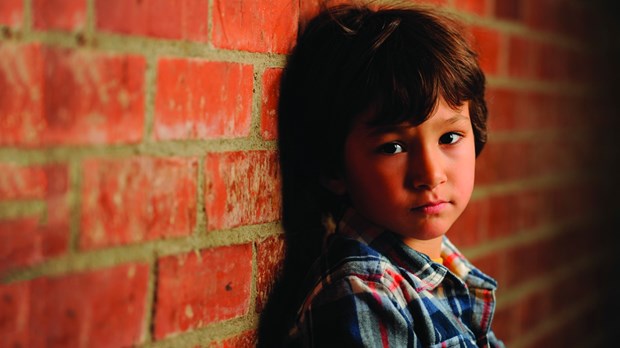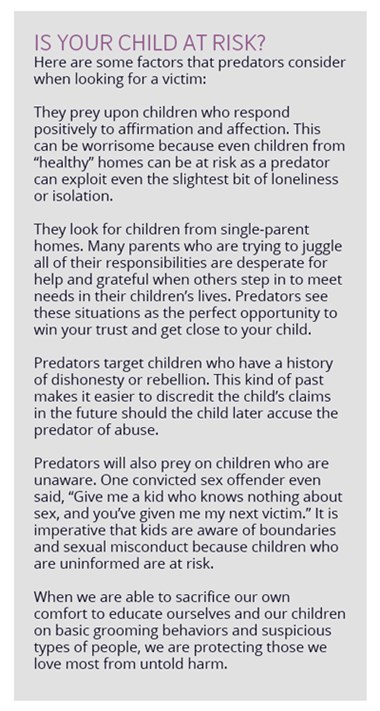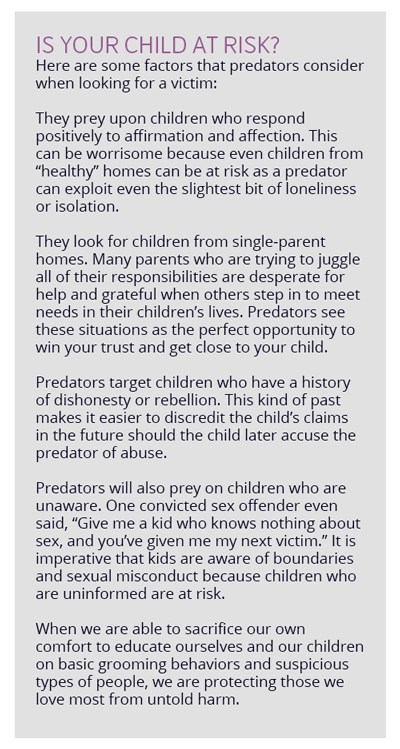How Predators Groom Our Children

“Has anyone ever touched you in your bathing suit areas?”
She asks the question lightly, trying not to put too much pressure on her four-year-old. Mother and daughter are “making breakfast” in a play kitchen, and it seems like a good time for a check-up.
“No, mommy,” the little girl says as she scrambles her invisible eggs.
Phew. “Good. And would you tell mommy if someone did touch you there?”
“Yep! Can we eat lunch now? I want a sandwich!”
As they get up and head to the kitchen, all is well.
If you’re anything like me, you might consider this due diligence for preventing or at least opening the lines of communication around sexual abuse. Unfortunately, with 1 in 4 girls and 1 in 6 boys sexually abused before the age of 18, the matter is much larger and much more complicated than we care to admit.
I remember the distress of many when Stephen Collins, the cherished patriarch and parishioner on the hit show 7th Heaven, was revealed as a child molester. Though he only played a pastor on TV, it was hard to imagine the walls of our church, even those on our small screens, compromised with such sin. Stephen Collins and Josh Duggar and Jordan Root are high-profile examples of a low-level truth: the sin is already inside our churches and our communities. Sexual predators are among us, and it requires much more than a few cagey conversations with our kids to fight this evil.
Targeting the Church
“I considered church people easy to fool. . . . They have a trust that comes from being Christians. They tend to be better folks all around and seem to want to believe in the good that exists in people.”
This quote from a convicted child molester who spoke with Dr. Anna Salter for her book Predators: Pedophiles, Rapists, and Other Sex Offenders expresses what many people implicitly understand but rightly fear: the church is not always a safe place for children. In fact, some studies claim that the church is more vulnerable to abuse than secular environments.
But how can that be true? Why would the church, a place of literal sanctuary, be more vulnerable?
Some guess that it’s because the church hosts so many classes, events, and activities for children there is simply a higher likelihood of abuse occurring. Another explanation may be that there is an underlying respect for authority within the church, so parents will be more trusting and children will be less likely to report abuse.
Surprisingly, the Abel and Harlow Child Molestation Prevention study revealed that 93 percent of sex offenders identified themselves as “religious.” And, according to Boz Tchividhian’s “Startling Statics,” “Other studies have found that sexual abusers within faith communities have more victims and younger victims.”
There are many steps that churches can take to protect their children and their ministries, but what can you as a parent do to prevent sexual abuse and protect your children from a possible predator?
Take heart—there is power in knowledge. By simply learning about common traits of sexual predators, educating yourself on their typical grooming habits (the ways they seek to target and desensitize their victims), and actively seeking to educate and empower your children with this same information, you are already making a difference. Protecting your children is a daunting, scary task, but it’s not impossible.
Know the Profile
Culture has inundated us with images of child predators as weak, lanky men with thin hair and rabid eyes. But to the contrary, these predators are usually charming, socially-adept, intelligent, and well-dressed. Like a chameleon, they take the shape of whatever they need in order to get close to their victim, and often that looks like a friendly, trustworthy volunteer, coach, or teacher.

Statistically, men are more likely to sexually abuse children than women (though because the victims of women are far less likely to report abuse, these numbers may be a little skewed). Both male and female predators will seek out employment or volunteer opportunities where they will have regular, prolonged exposure to children (daycare or nursery workers, doctors, babysitters, and so on)—it’s important to note that only 10 percent of child molesters abuse children they don’t know. In fact, predators will likely be grooming or abusing more than one child at a time, with estimates of male offenders averaging 75 victims in total.
In addition to constructing a social circle that seeks opportunities to be with children, the majority (68 percent) of convicted child molesters will abuse children in their own families, whether that be their own kids, nieces and nephews, siblings, or even grandchildren.
The Center for Behavioral Intervention conducted interviews with convicted sexual predators, and one man seconded this statistic: “Parents are so naive—they’re worried about strangers and should be worried about their brother-in-law. They just don’t realize how devious we can be. I used to abuse children in the same room with their parents and they couldn’t see it or didn’t seem to know it was happening.”
So because these predators are able to assimilate so easily into our churches and lives, parents must become aware of the red flags. By learning what to look for in a predator, parents can take control of these situations—we are not helpless victims here.
Know the Signs
Discussing grooming behaviors could be the key to increasing your child’s awareness and even identifying and removing a predator from your midst. By the time a child is touched sexually, grooming has already taken place. Therefore, we need to be learning about all of the steps that come before the “bathing suit zones” so we can prevent these tragedies from even occurring.
The process of grooming increases exposure to a child and decreases the likelihood of being discovered. Ultimately, successful predators will seek to recognize and exploit needs in a child’s life, and grooming enables them to do just that. We often underestimate how premeditated this kind of abuse is—in reality, sexual predators can be grooming a child for months and even years before sexual acts occur. During this time, there are five stages that typically occur in grooming, each one acclimating the child more and more to the advances of the predator.
1. Establishing a relationship and building trust with the child
In this initial phase, a predator may pretend to share common interests with a child, often one that he claims is his “favorite” or “special friend.” A predator will use this period to shower the child gifts or privileges in order to earn their favor, even providing access to activities typically off-limits (“We don’t usually allow anyone to get into the craft closet, but let’s sneak in there and see what we can find.”).
During this time, the predator will also establish himself as a close friend and confidant, offering a sympathetic and understanding perspective, saying things like “No one understands, but I do” or “I know exactly what that’s like.”
Ultimately, the sex offender gains the child’s trust by meeting the needs that he has intentionally observed. What makes this phase particularly difficult to identify is that sex offenders will closely resemble the loving, responsible caretakers that your child may be surrounded by. Because only more uncomfortable or overly personal interactions warrant a parent’s suspicion, these predators are able to slip under the radar with their attentive, intuitive interactions.
2. Establishing a relationship and building trust with the family
When a predator targets your child, he is also targeting your family. As one offender said, “You don’t just go up and get the child and sexually molest the child. There’s a process of obtaining the child’s friendship and, in my case, also obtaining the family’s friendship and their trust. When you get their trust, that’s when the child becomes vulnerable.”
Predators will often target parents who are in need of support or single parents, even going so far as to initiate romantic relationships with a parent in order to eventually gain access to the child. They also tend to be the perfect caretaker: responsible, prompt, loving, and attentive, behaving in a way that is above reproach so as to earn respect and trust.
During this phase, predators may also begin to subtly discredit the child to the parents, suggesting that the child is troubled, unstable, or dishonest (perhaps saying something as simple as “Mary said that she didn’t get lunch before she came. Is that true?” when they know that Mary had in fact eaten right before coming). These seeds make it easier for the predator to deny accusations should suspicious behavior be reported later.
3. Gradually eroding boundaries
The initial physical contact between a predator and his victim is often nonsexual. Predators will test the child’s reaction to affection and touching, evaluating their response and responsiveness. As well as acting as a gauge, these actions are meant to desensitize the child to touch—nonsexual gestures, such as “accidental” and minor touches (putting an arm around a shoulder, brushing away a piece of hair, even giving hugs) serve to test the natural limits of a child while easing them into comfortable, prolonged physical contact. This phase breaks down inhibitions and gives way to more overt sexual touching.
Perhaps most surprisingly, much of this grooming is also done in public. Many assume that these actions take place in isolation or behind closed doors, but predators will intentionally (and seemingly harmlessly) initiate this kind of contact (hugging, kissing on the cheek, or grazing) in front of friends and family. First, by establishing a close relationship in public, people become less suspicious of what goes on in private (many wrongly assume that sexual predators would not act so brazenly for fear of being caught). And by breaking down these boundaries in front of parents, it creates a false sense of security where the child feels that there is nothing inappropriate in this behavior, sensing that you are comfortable with the touching. (A good tip is to never force your child to hug or show affection to someone if they are uncomfortable doing so. They should never think that forced closeness is condoned.)
4. Constructing a secret relationship with the child
During this phase, a predator will treat the child as a “co-conspirator” as they exchange secrets and undertake special projects together. A sexual predator will even share secrets with the victims, making them believe that they are trusted and valued. This kind of relationship makes it easier to ask for reciprocation in keeping a secret with the child. The abuser will often use language like “Your parents would be so mad if they found out that we ate some candy. Let’s keep it between us” in an effort to pit the pair against the parents.
As the predator will continue to touch the victim, telling him that the touching is good, he will also threaten the victim with repercussions if the child were to tell: “We can no longer be friends if you tell your parents” or “If you tell mommy, you’ll never get to play games with me again. Is that what you want?”
5. Working to secure compliance
At this stage, the predator already has a strong relationship with both the parents and the child. He has introduced the victim to inappropriate touches, has won their trust, and has used that trust to exchange secrets. Now he will continue to escalate the sexual behavior, manipulating the child into performing lewd acts. As the child feels increasing loyalty to the predator or even pleasure from the sexual acts, he will become less and less likely to report the abuse.
How to Protect Your Child
“Children require the protection of adults, usually from adults. Their fear of people is not yet developed, their intuition not yet loaded with enough information and experience to keep them from harm,” writes Gavin De Becker in The Gift of Fear.
So what can you do? How can you protect your child?
Build a relationship of open and trusting communication with your child. They should know that they can come to you with concerns.
Monitor their online activity to be aware of who they are communicating with.
Visit schools and practices unannounced and always ask questions regarding hiring processes, background checks, and vetting.
Ultimately, education is key here. The threat of sexual abuse, especially at the hands of someone close to your family, is terrifying. But that fear should not paralyze you; instead, let it motivate you to learn more about predators, about their actions and habits. Remember that predators gain power from your ignorance and empathy, so take back control by learning as much as you can.
But you won’t be around for every situation—so you need to pass that knowledge onto your children. Begin talking with them about sex and anatomy at an early age. Don’t be afraid to do more than explain the “bathing suit zones” as they get older. They need to have a clear understanding and ownership of their bodies.
Teach your children about these grooming behaviors. Ask questions, even about adults in your family or church. While stranger danger is a real threat, so are those closest to you.
No parent wants to imagine a child being sexually abused, but by acknowledging the threat and actively evaluating the actions, habits, and behaviors of those around you, you are loving your children by protecting them.
Read more articles that highlight writing by Christian women at ChristianityToday.com/Women
 Read These Next
Read These Next
 How to Tell Your Kids No—Even Though You Did ItDon't let guilt keep you from discussing sensitive issues.
How to Tell Your Kids No—Even Though You Did ItDon't let guilt keep you from discussing sensitive issues.
 How I Ruined My MarriageOne divorced woman’s cautionary tale
How I Ruined My MarriageOne divorced woman’s cautionary tale








 Homepage
Homepage

